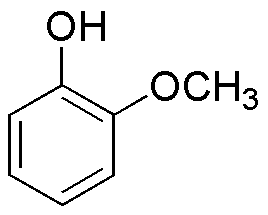Guaiacol is widely utilized in research focused on:
- Flavoring and Fragrance Industry: Guaiacol is commonly used as a flavoring agent in food products and as a fragrance component in perfumes and cosmetics, providing a pleasant smoky aroma.
- Pharmaceuticals: It serves as a key ingredient in cough syrups and expectorants, helping to relieve coughs and clear mucus from the respiratory tract.
- Analytical Chemistry: Guaiacol is used in various analytical methods, including chromatography, to identify and quantify phenolic compounds in different samples.
- Wood Preservation: Its antimicrobial properties make it effective in wood preservation, protecting against rot and decay, which is beneficial for the construction and furniture industries.
- Research Applications: Guaiacol is used in laboratories for synthesizing other chemical compounds, making it valuable for researchers in organic chemistry and material science.
General Information
Properties
Safety and Regulations
Applications
Guaiacol is widely utilized in research focused on:
- Flavoring and Fragrance Industry: Guaiacol is commonly used as a flavoring agent in food products and as a fragrance component in perfumes and cosmetics, providing a pleasant smoky aroma.
- Pharmaceuticals: It serves as a key ingredient in cough syrups and expectorants, helping to relieve coughs and clear mucus from the respiratory tract.
- Analytical Chemistry: Guaiacol is used in various analytical methods, including chromatography, to identify and quantify phenolic compounds in different samples.
- Wood Preservation: Its antimicrobial properties make it effective in wood preservation, protecting against rot and decay, which is beneficial for the construction and furniture industries.
- Research Applications: Guaiacol is used in laboratories for synthesizing other chemical compounds, making it valuable for researchers in organic chemistry and material science.
Documents
Safety Data Sheets (SDS)
The SDS provides comprehensive safety information on handling, storage, and disposal of the product.
Product Specification (PS)
The PS provides a comprehensive breakdown of the product’s properties, including chemical composition, physical state, purity, and storage requirements. It also details acceptable quality ranges and the product's intended applications.
Certificates of Analysis (COA)
Search for Certificates of Analysis (COA) by entering the products Lot Number. Lot and Batch Numbers can be found on a product’s label following the words ‘Lot’ or ‘Batch’.
*Catalog Number
*Lot Number
Certificates Of Origin (COO)
This COO confirms the country where the product was manufactured, and also details the materials and components used in it and whether it is derived from natural, synthetic, or other specific sources. This certificate may be required for customs, trade, and regulatory compliance.
*Catalog Number
*Lot Number
Safety Data Sheets (SDS)
The SDS provides comprehensive safety information on handling, storage, and disposal of the product.
DownloadProduct Specification (PS)
The PS provides a comprehensive breakdown of the product’s properties, including chemical composition, physical state, purity, and storage requirements. It also details acceptable quality ranges and the product's intended applications.
DownloadCertificates of Analysis (COA)
Search for Certificates of Analysis (COA) by entering the products Lot Number. Lot and Batch Numbers can be found on a product’s label following the words ‘Lot’ or ‘Batch’.
*Catalog Number
*Lot Number
Certificates Of Origin (COO)
This COO confirms the country where the product was manufactured, and also details the materials and components used in it and whether it is derived from natural, synthetic, or other specific sources. This certificate may be required for customs, trade, and regulatory compliance.


